1875 Season
Gulf or Northern ice only twice in Fortune Bay for the last 30 years (1857-1887), 1875 and 1876. (GR).
First Northern ice to be seen at Gaultois since 1855. (GR p.99)
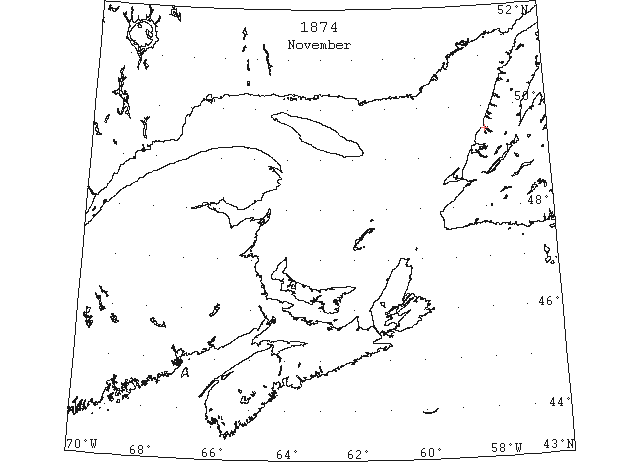
Nov 27 Local ice formed Bonne Bay. (GR p.85)
Dec 13 “Isaac Merrit” which was sunk by the ice at Allyn’s Point [U.S.A?] Dec. 31 has been raised and was taken to New York for repairs. (NYMR)
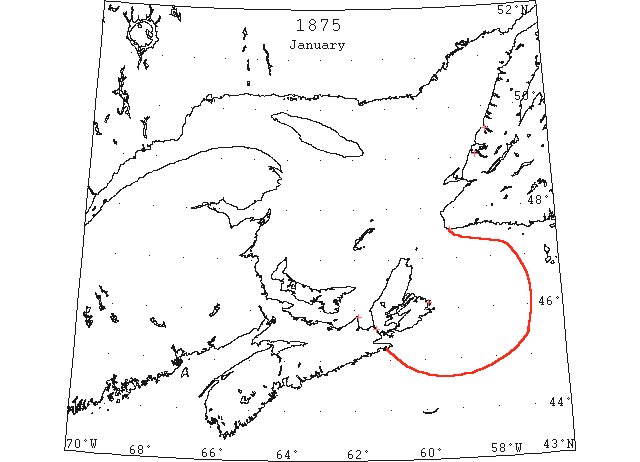
Jan 1 Local ice formed Bay of Islands. (GR p.88)
Jan 3 & 29 Mention of ice in the Straits of Canso. (LL).
Jan 6 Duke of York (Br.) was recently abandoned in the ice off Cape Georgia [sic]. (NYMR)
Jan 13 Northern ice arrived Bonne Bay. (GR p.85)
Jan 15 SS “Canadian” from Liverpool to Baltimore passed large quantities of ice before reaching Newfoundland and between Newfoundland and Halifax. (LL).
Jan 27 Heavy ice passing out [Arriving Channel]. (GR p.33& 39)
Jan 27 “Hero” (of Belfast) was caught in the ice near Fort Knox [Maine?], night of Jan 15 and driven ashore where she was filled. The crew crawled over ice planks to the shore. (NYMR)
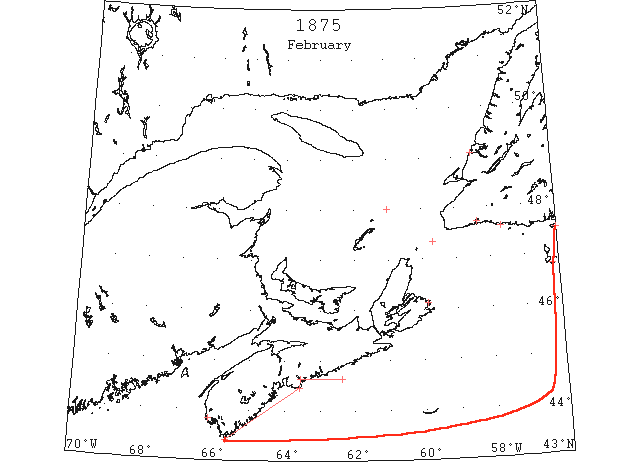
Feb issue: “The ice-blockade of the Middle and East Atlantic coast, which has not been exceeded in severity before during the present century, being comparable to that of 1780.” and also navigation in New York Bay from Jan 15 to Feb 25 most severe obstruction since 1847. (MWR).
Feb Northern ice arrived Bay of Islands. (GR p.88)
Feb 1 Halifax, the steamer “Alhambra,” which arrived from Boston yesterday morning reports that the steamer passed through a large quantity of ice from Cape Sable to Sambro and that the weather during the passage was colder than he ever experienced before. (AR 16/02/1875 p3 #3)
Feb 3 Halifax, arrived brigt “Peerless,” sailed January 4th for Cow Bay, had to return on account of ice. ([AR?] 03/02/1875 p3 #3)
Feb 8 Gulf ice arrived La Poile. (GR p.35&92)
Feb 14 Gulf ice arrived Burgeo. (GR p.35&94)
Feb 16 Gulf full, Cabot Strait full. (GR p.33)
Feb 16 SS “Neptune” arrived from Halifax (13th ?), reports quantities of ice nearly all the way. (Newf.).
Feb 17 “WH Scott”, steam tug, while towing out of Portland Feb 13 schr. Hattie G Dow, for New Orleans, got into the ice and was run into by the latter. (NYMR)
Feb 17 “Carrie Purington” from Leghorn for Boston, put into Provincetown Feb 5 for a harbor, on account of head winds and when leaving the harbor 10th was forced by ice on the bar and remained, surrounded by ice in 6 feet water at low tide, but floating at high tide. She remained in ice between Wood End and Truro 16th. (NYMR)
Feb 17 Halifax, a schr adrift Yarmouth, to all appearance a derelict, has been floating about in the bay for a day or so. There is so much ice on the coast that it has been found impossible to board her. To appearance she has been ashore some where, or possibly has been carried by the ice out of some harbour on the American coast or elsewhere. (AR 18/02/1875 p3 #4)
Feb 18 There is an ice floe off Halifax for a distance of 50m, The Chesapeake is frozen over and the Potomac is closed to navigation. (LL).
Feb 19 The Yarmouth harbour, NS is blocked with ice. (LL).
Feb 20 Gulf ice arrived Gaultois, Harbour Breton and St. Pierre. (GR p.35&100)Feb 22 Gulf ice arrived Gaultois. First time since 1855. (GR p.99)
Feb 24 “E.A. Woodward” from Provincetown to New York, before reported having been ashore on Falkner’s Island, and seen in ice Feb 15, with signal of distress flying, was again seen 17th, full of water and abandoned. (NYMR)
Feb 25 Ice extending to Burgeo. (GR p.33)
Feb 30[sic] Gulf ice approached St.Pierre; left April 29. {GR p.29)
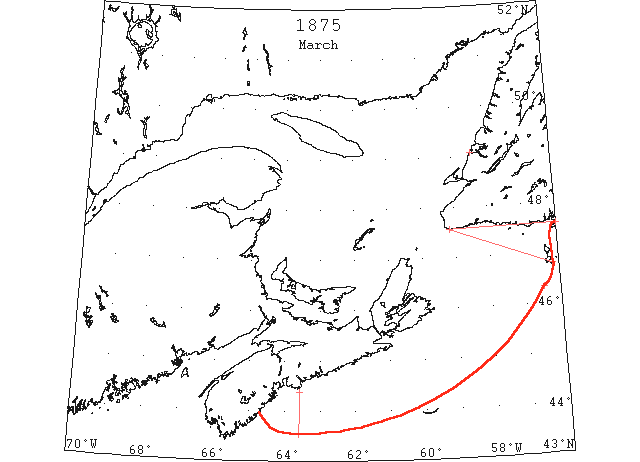
March issue: European steamships arriving at U.S. ports in March reported unusually enormous ice-fields and icebergs, floating southward off the Atlantic coast. (MWR).
Mar 2 Issue: SS “Eleanora” from New York to Portland reports having passed through ~110m of ice [many other mentions of ice on eastern seaboard from Cape Cod to Baltimore and Boston]. (LL).
Mar 4 “Daisy” from Cienfuegos to Halifax reports having passed through 50m of heavy ice up to within 5m of Sambro Head. (LL).
Mar 10 :Eva G.”, fisherman, of Boston, which had been sunk in the ice off Sandwich, Mass., sunk on Mar 10. (NYMR)
Mar 12 SS “Geo Shattuck” saw ice 30m SSW of St. Pierre. (NYMR).
Mar 13 Northern ice departed Bay of Islands. (GR p.88)
Mar 17 Steamer “Geo Shattuck” from St. Pierre Miquelon, 15 days out Halifax NS is supposed to have been seen in ice 30 miles SSW from St. Pierre, Miquelon, Mar 12. (NYMR)
Mar 17 “CW Oulton” (Br.) from Liverpool for Harbor Grace, put into Shelburne NS, March 9, short of provisions. Reports had very heavy weather and is badly damaged by ice. (NYMR)
Mar 17 “Willie R. Weber”, fisherman, was sunk by being cut through by the ice at Provincetown, and lies in 3 fathoms water where she sunk. (NYMR)
Mar 19 SS “George Shattuck” from St. Pierre to Halifax reports having been jammed in the ice for 14 days. (LL).
Mar 23 Channel rafted up, ice all along the south coast to Harbour Breton and St. Peters. (GR p.33)
Mar 24 Steamer [?] “Shaltnek” [“Shattuck”?], which arrived at Halifax Mar 18, reports left St. Pierre on the 2nd; was jammed in the ice 14 days; sustained no serious damage. Saw a bark and a brig, supposed French, in the ice, bound into St. Pierre. (NYMR)Mar 27 St. Pierre enveloped in ice extending 25 miles SE of that island. (GR p.94)
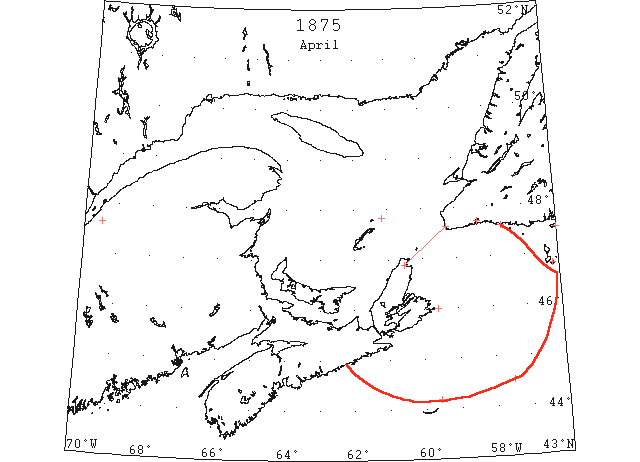
Apr 3 “Lady Head” arrived after an ineffectual attempt to reach Sable Is., the ice preventing her from getting within 20m of that place. (LL).
Apr 9 SS “Gellert” from Hamburg to New York 43°N 56°W passed some bergs. (LL).
Apr 16 Northern ice departed Bonne Bay. (GR p.85)
Apr 17 A telegram from Newfoundland states ” The first ship passed West Point [Anticosti?] on the 16th no ice here; reports plenty from the Birds Rocks to Cape St. George.” (LL).
Apr 17 Ice departed La Poile. (GR p.35&92)
Apr 18 A telegram from Watertown, New York states that the St. Lawrence is free for 100 miles from its mouth and navigation may be resumed. (LL)
Apr 18 North Sydney, the harbor is clear of ice and a schooner has arrived to port today. (HDR&T 18/04/1876 p2 #5)
Apr 19 Brig “Constantine” from Sydney to St. Pierre caught in ice and lost on Salmon Head 2m east of Port aux Basque. (NYMR)
Apr 20 Gulf ice left St. Pierre. (GR p.29&35)
Apr 20 The ice in the harbour is breaking up rapidly. The vessels frozen in at the Three Tides have made their way back to the wharves, and are being discharged. The ferry steamers are about ready for work, and we believe a few more days will see them plying regularly. (Pat 20 Apr p2#4)
Apr 22 The “George Washington” arrived here from Newfoundland at 9:15 o’clock this morning. She started from this port five days later than the RMS “Newfoundland” and fortunately escaped the ice blockade which the latter experienced, and arrived at her destination six days earlier. She sails for New York at six o’clock this evening. (HDR&T 22/04/1876 p2 #5)
Apr 24 Ice is moving around Montreal and Cape Rouge efforts are being made to blast it with gun cotton. (LL).
Apr 24 The SS “Albert” arrived at Pictou, today from Georgetown, P.E.I. and reports heavy ice in the strait, but that it is scattered in the Eastern and Southern parts. (LL).
Apr 25 The schooner “Thetis” was forced ashore by ice on Cherry Valley Bar. (LL)
Apr 26 The “Acadian” sailed for Pictou yesterday afternoon. The “George Shattuck” arrived here last night at half-past nine from St. Pierre, Miquelon. She was unable to get into Sydney on account of the ice, which was fast closing in. (HDR 26/04/1876 p2 #6)
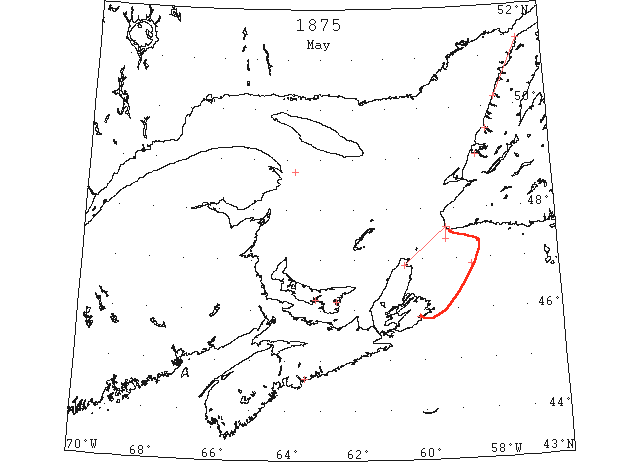
May 1 Schooner “Stronna” “Stronsa?” from Halifax to Cow Bay and Sydney, CB struck an iceberg off Gabaroussa [sic] and sank; crew saved. Other reports say stranded on ice. (LL)
May 1 The ice in the harbour is beginning to look shaky. The channel is open quite a long distance. Travelling on the ice is suspended. – S.J. (Pat 1 May p2#3)
May 1 This, the first of May, is a cold, raw, windy day. There is a great deal of ice in our harbours and around the coast, and but few signs of an immediate break up. (Pat 1 May p2#5)
May 1 The ice was sound enough on the Georgetown harbour on the first of May to allow of persons crossing it on foot. (Pat 6 May p2#1)
May 3 A letter from Cape Ray, NF, dated May 3 says: The ice is very bare yet. Not a single open space of water to be seen with a glass from the top of the lighthouse. The ice is piled up and rough. Vessels for the seal fishery have a poor prospect owing to the large quantities if ice in the Gulf. (NYMR 26 May)
May 4 “Emma” beset off Portland Creek and lost on the Flowers Ledges, May 5. (GR p.30)
May 8 Local ice cleared Bay of Islands. (GR p.88)
May 13 The Gulf blocked. (GR p.31&33)
May 16 Local ice cleared Bonne Bay. (GR p.85)
May 19 The SS “Roma” arrived from Montreal having been 6 days in the ice 70m off St. Paul’s. (PL).
May 20 Ice departed Channel. (GR p.35)
May 21 The “Hibernia” at Halifax on 18th tried for 2 days to enter this harbour and was at last obliged to proceed west, having carried away 3 blades of her propeller in the ice. (Newf.).
May 23 Bark “M. Wood” (Br.) at Shediac May 23 from Liverpool, reports was on the Cape Breton coast in 19 days, but she was detained by ice and had to go as far north as Gaspé to get around it. On the Cape Breton coast she met 200 sail of vessels bound in the ice, not hurt, and with some sails set. Also two other deserted vessels. (NYMR)
May 30 Bonne Bay coast clearing. [also] West coast of Newfoundland not clear until this date. (GR p.31&33)
Jun issue: “the immense masses of drift ice and the long-continued presence of icebergs in the North Atlantic, greatly affecting the weather in all the Atlantic States”. ..Ice drift and icebergs unusually large and late … . “The steamship Caspian, which touched at St. John’s on July 1st, was five days among the icebergs, and previous to that day, steamships could not get to St. John’s on account of ice-obstructions.” (MWR).
“The quantity of ice reported has been greater than that of any year since 1875.” (MWR June 1880).
Nova Scotia and Bay of Fundy Pilot, London, 1947: “The approaches to Halifax harbour are always navigable. The harbour has been frozen over 3 times only since 1850 and on no occasion for more than a short time. A thick coating of ice formed in the unusually severe winter of 1874-5. The harbour may therefore be considered as never being closed by ice unless in most exceptional circumstances. (CIS IC1089)